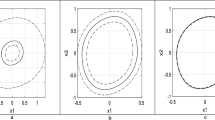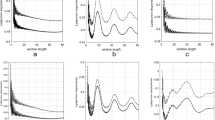Abstract
Estimation of the degree of stability and the bounds of solutions to nonautonomous nonlinear systems present major concerns in numerous applied problems. Yet, current techniques frequently yield overconservative conditions which are unable to effectively gage these characteristics in time-varying nonlinear systems. This paper develops a novel methodology providing successive approximations to solutions that are stemmed from the trapping/stability regions of these systems and estimate the errors of such approximations. In turn, this leads to successive approximations of both the bilateral bounds of solutions and the boundaries of trapping/stability regions of the underlying systems. Along these lines we formulate enhanced stability/boundedness criteria and contrast our inferences with inclusive simulations which reveal dependence of the trapping/stability regions upon the structure of time-dependent components and initial time moment.






Similar content being viewed by others
References
Bacciotti, A., Rosier, L.: Lyapunov Functions and Stability in Control Theory, 2nd edn. Springer, Berlin (2005)
Khalil, H.: Nonlinear Systems, 3rd edn. Prentice-Hall, Upper Saddle River (2002)
Khalil, H.: Nonlinear Control. Prentice-Hall, Upper Saddle River (2015)
Lyapunov, A.M.: Stability of Motion. Academic Press, New York (1982)
Daletskii, Yu.L., Krein,M.G.: Stability of Solutions of Differential Equations in Banach Space. Amer. Math. Soc., Tran. of Math. Monographs, vol. 43, Providence, RI (1974)
Barbashin, E.A.: Introduction to the Theory of Stability. Wolters-Noordhoff, Groningen (1970)
Leonov, G.A.: Strange Attractors and Classical Stability Theory. World Scientific, Singapore (2006)
Leonov, G.A., Kuznetsov, N.V.: Time-varying linearization and the Peron effects. Int. J. Bifurc. Chaos 17, 1079–1107 (2007)
Mazenc, F.: Strict Lyapunov functions for time-varying systems. Automatica 39, 349–353 (2003)
Malisoff, M., Mazenc, F.: Further remarks on strict input-to-state stable Lyapunov functions for time-varying systems. Automatica 41, 1973–1978 (2008)
Michel, A.N., Hou, L.: Stability results involving time-averaged Lyapunov function derivatives. Nonlinear Anal. Hybrid Syst. 3, 51–64 (2009)
Zhou, B.: Stability analysis of non-linear time-varying systems by Lyapunov functions with indefinite derivatives. IET Control Theory Appl. 8, 1866–1874 (2017)
Peuteman, J., Aeyels, D.: Averaging results and the study of uniform asymptotic stability of homogeneous differential equations that are not fast time-varying. SIAM J. Control Optim. 37, 97–1010 (1999)
Peuteman, J., Aeyels, D.: Exponential stability of nonlinear time-varying differential equations and partial averaging. Math. Control Signals Syst. 15, 42–70 (2002)
Naser, M.F., Ikhouane, F.: Stability of time-varying systems in the absence of strict Lyapunov functions. IMA J. Math. Control Inf. 36, 461–483 (2019)
Abbaszadeh, M., Marquez, H.J.: Nonlinear observer design for one-sided Lipschitz systems. In: Proceedings of American Control Conference, vol. 30, pp. 5284–5289, Baltimore, MD (2010)
Abbaszadeh, M., Marquez, H.J.: Design of nonlinear state observers for one-sided Lipschitz systems. arXiv:1302.5867 (2013)
Van Loan, C.: The sensitivity of matrix exponentials. SIAM J. Numer. Anal. 14, 971–981 (1977)
Zevin, A.A., Pinsky, M.A.: Exponential stability and solution bounds for systems with bounded nonlinearities. IEEE Trans. Autom Control 48, 1799–1804 (2003)
Giesl, P., Hafstein, S.: Review on computational methods for Lyapunov functions. Discrete Control Dyn. Syst. Ser. B 20(8), 2291–2331 (2015)
Chiang, H.-D., Alberto, L.F.C.: Stability Regions for Nonlinear Dynamical Systems. Cambridge University Press, Cambridge (2015)
Tan, W., Packard, A.: Stability region analysis using polynomial and composite polynomial Lyapunov functions and sum-of-squares programming. IEEE Trans. Autom. Control 53, 565–571 (2008)
Topcu, U., Packard, A., Seiler, P.: Local stability analysis using simulations and sum-of-squares programming. Automatica 44, 2669–2675 (2008)
Topcu, U., Packard, A., Seiler, P., Balas, G.: Robust region of attraction estimation. IEEE Trans. Autom. Control 55, 137–142 (2010)
Khodadadi, L., Samadi, B., Khaloozadeh, H.: Estimation of region of attraction for polynomial nonlinear systems: a numerical method. ISA Trans. 53(1), 25–32 (2014)
Najafi, E., Babusˇka, R., Lopes, G.: A fast sampling method for estimating the domain of attraction. Nonlinear Dyn. 86(2), 823–834 (2016)
Valmorbida, G., Anderson, J.: Region of attraction estimation using invariant sets and rational Lyapunov functions. Automatica 75, 37–45 (2017)
Chiang, H.D., Thorp, J.: Stability regions of nonlinear dynamical systems: a constructive methodology. IEEE Trans. Autom. Control 34(12), 1229–1241 (1989)
Genesio, R., Tartaglia, M., Vicino, A.: On the estimation of asymptotic stability regions: state of the art and new proposals. IEEE Trans. Autom. Control 30, 747–755 (1985)
Genesio, R., Vicino, A.: New techniques for constructing asymptotic stability regions for nonlinear systems. IEEE Trans. Circuits Syst. 31, 574–581 (1984)
Loccufier, M., Noldus, E.: A new trajectory reversing method for estimating stability regions of autonomous nonlinear systems. Nonlinear Dyn. 21, 265–288 (2000)
Kant, N., Mukherjee, R., Chowdhury, D., Khalil, H.: Estimation of the region of attraction of underactuated systems and its enlargement using impulsive inputs. IEEE Trans. Robot. 35, 618–632 (2019)
Koo, T.J., Su, H.: A computational approach for estimating stability regions. In: Proceedings of IEEE Conf. Computer Aided Control Systems Design. Munich (2006)
Yuan, G., Li, Y.: Estimation of the regions of attraction for autonomous nonlinear systems. Trans. Inst. Meas. Control 41(1), 97–106 (2019)
Chiang, H.D., Hirsch, M.W., Wu, F.F.: Stability regions of nonlinear autonomous dynamical systems. IEEE Trans. Autom. Control 33, 16–27 (1988)
Chiang, H.D., Wang, T.: On the number and types of unstable equilibria in nonlinear dynamical systems with uniformly-bounded stability regions. IEEE Trans. Autom. Control 61(2), 485–490 (2016)
Wang, T., Chiang, H.D.: On the number of unstable equilibrium points on spatially-periodic stability boundary. IEEE Trans. Autom. Control 61(9), 2553–2558 (2016)
Chen, Y., et al.: Characterizing regions of attraction for piecewise affine systems by continuity of discrete transition functions. Nonlinear Dyn. 90, 2093–2110 (2017)
Lohmiller, W., Slotine, J.-J.E.: On contraction analysis for non-linear systems. Automatica 34(6), 683–696 (1998)
Malikov, A.: Ellipsoidal estimation of solutions of differential equations using matrix comparison systems. Russ. Math. (Izvestiya VUZ. Matematika) 46(8), 27–39 (2002)
Malikov, A.: State estimation and stabilization of continuous systems with uncertain nonlinearities and disturbances. Autom. Remote Control 77, 764–778 (2016)
Amato, F., et al.: Finite Time Stability and Control. Springer, Berlin (2014)
Pinsky, M.A., Koblik, S.: Solution bounds, stability, and estimation of trapping/stability regions of some nonlinear time-varying systems. Math. Probl. Eng. Article ID 5128430, 16 pp (2020). https://doi.org/10.1155/2020/5128430
Perron, O.: Die ordnungszahlen linearer differentialgleichungssysteme. Math. Z. 31, 748–766 (1930)
Millionshchikov, V.: Structurally stable properties of linear systems of differential equations. Differentsial’nye Uravneniya 5, 1775–1784 (1969)
Bylov, B., Izobov, N.: Necessary and sufficient conditions for the stability of the characteristic exponents of a linear system. Differentsial’nye Uravneniya 5, 1794–1803 (1969)
Kauderer, H.: Nonlineare Mechanik. Springer, Berlin (1958)
Hamming, R.W.: Numerical Methods for Scientists and Engineers. McGraw-Hill, New York (1962)
Acknowledgements
The programs used to simulate the models in Sect. 8 of this paper were developed by Steve Koblik who also was engaged in discussions of the corresponding results.
Author information
Authors and Affiliations
Corresponding author
Ethics declarations
Conflict of interest
The author declares that he has no conflict of interest
Additional information
Publisher's Note
Springer Nature remains neutral with regard to jurisdictional claims in published maps and institutional affiliations.
Appendix
Appendix
Let us sketch, for instance, how to derive inequalities (7.2). Assume that \( f\left( {t,x} \right) = [f_{1} , \ldots ,f_{n} ]^{\text{T}} \), \( x,\,\,u\,,z \in {\mathbb{R}}^{n} \), \( f_{i} \left( {t,x} \right) = \zeta_{i} \left( t \right)x_{i}^{{d_{i} }} = \zeta_{i} \left( t \right)\left( {z_{i} + u_{i} } \right)^{{d_{i} }} ,\,\,d_{i} \in {\mathbb{N}} \). Thus, \( \left| {f_{i} } \right| = \left| {\zeta_{i} \left( {z_{i} + u_{i} } \right)^{{d_{i} }} } \right| \le \left| {\zeta_{i} } \right|\left| {z_{i} + u_{i} } \right|^{{d_{i} }} \)\( \le \left| {\zeta_{i} } \right|\left( {\left| {z_{i} } \right| + \left| {u_{i} } \right|} \right)^{{d_{i} }} \le \left| {\zeta_{i} } \right|\left( {\left\| z \right\| + \left| {u_{i} } \right|} \right)^{{d_{i} }} \)\( \le \left| {\zeta_{i} } \right|\left( {\left\| z \right\| + \left\| u \right\|} \right)^{{d_{i} }} \).Then, taking into account that \( \left\| f \right\| \le \left\| f \right\|_{1} = \sum\nolimits_{i = 1}^{n} {\left| {f_{i} } \right|} \), we infer that \( \gamma_{*} \left( {t,u} \right) = \sum\nolimits_{i = 1}^{n} {\left| {\zeta_{i} } \right|\left| {u_{i} } \right|^{{d_{i} }} } \), \( \varPi_{*} \left( {t,y} \right) = \,\sum\nolimits_{i = 1}^{n} {\left| {\zeta_{i} } \right|\left( {\left\| z \right\| + \left| {u_{i} } \right|} \right)^{{d_{i} }} } - \gamma_{*} \left( {t,u} \right) \), \( \hat{\gamma }\left( {t,\left\| u \right\|} \right) = \sum\nolimits_{i = 1}^{n} {\left| {\zeta_{i} } \right|\left\| u \right\|^{{d_{i} }} } \) if \( F_{0} = 0 \). Subsequently, we enter in this formula that \( \left\| u \right\| \le \left\| u \right\|_{1} \). The prior formula holds if \( F_{0} > 0 \) with obvious change in notation.
Assume next that \( f_{id} \left( {t,x} \right) = \zeta_{id} \left( t \right)x^{d} \), where \( x^{d} = x_{1}^{{d_{1} }} \ldots x_{n}^{{d_{n} }} ,\,\,d_{i} \in {\mathbb{Z}},\,\,\,d = \sum\nolimits_{i = 1}^{n} {d_{i} } \). Then, \( \left| {f_{id} \left( {t,x} \right)} \right| = \left| {\zeta_{id} } \right|\left| {x_{1}^{{d_{1} }} } \right| \ldots \left| {x_{n}^{{d_{n} }} } \right| \) which enables utility of the prior procedure for every \( \left| {x_{i}^{{d_{i} }} } \right| \). Clearly, such sequence of steps yields (7.2) if \( f\left( {t,x} \right) \) is a vector polynomial in \( x \).
Rights and permissions
About this article
Cite this article
Pinsky, M.A. Successive estimations of bilateral bounds and trapping/stability regions of solution to some nonlinear nonautonomous systems. Nonlinear Dyn 103, 517–539 (2021). https://doi.org/10.1007/s11071-020-06033-3
Received:
Accepted:
Published:
Issue Date:
DOI: https://doi.org/10.1007/s11071-020-06033-3




